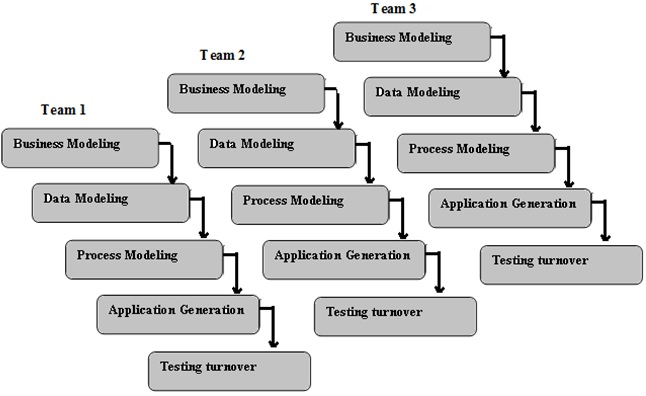rad快速应用程序开发
MIS中的SDLC RAD模型 (SDLC RAD Model in MIS)
RAD stands for "Rapid Application Development"; this model is used to develop a system rapidly. In this model, overall project tasks divided into more than one team. Each team works to develop the system according to SDLC phases. When a system needs to develop in a very short time then the RAD model is the most suitable option amongst available SDLC models.
RAD代表“快速应用程序开发” ; 该模型用于快速开发系统。 在此模型中,总体项目任务分为多个团队。 每个团队都根据SDLC阶段来开发系统。 当系统需要在很短的时间内开发时,RAD模型是可用的SDLC模型中最合适的选择。
Followings are the phases of the RAD model,
以下是RAD模型的各个阶段 ,
Business Modeling
业务建模
Data Modeling
资料建模
Process Modeling
流程建模
Application generation
应用程序生成
Testing and turnover
测试与周转
The initial task starts with communication between expert developers and customers. Planning is one of the most important criteria, after planning the overall process divides into classes. More essential is planning to work together on various project activities.
初始任务从专家开发人员和客户之间的沟通开始。 计划是最重要的标准之一,计划后将整个过程分为几类。 更重要的是计划在各种项目活动中进行合作。

Figure: RAD Model
图:RAD模型
The different phases of RAD model are as follows,
RAD模型的不同阶段如下:
1)业务建模 (1) Business Modeling)
Business analysis is required to obtain the necessary business information. Business Modeling is the transfer of knowledge between different roles within the enterprise. For example, what type of information each function generates, and what are the functions for handling that information.
需要进行业务分析以获取必要的业务信息。 业务建模是企业内不同角色之间的知识转移。 例如,每个函数生成什么类型的信息,以及处理该信息的函数是什么。
2)数据建模 (2) Data Modeling)
The knowledge is distilled into the collection of objects in the business modeling process and is important for the business. That object's attributes are established and the relation between the objects is defined.
知识在业务建模过程中被提取到对象集合中,并且对于业务很重要。 建立对象的属性,并定义对象之间的关系。
3)流程建模 (3) Process Modeling)
To enforce the business model, the data objects identified in the data modeling process are modified to fulfill the information flow. The definition of the process is created to add, modify, remove or retrieve a data object.
为了实施业务模型,对数据建模过程中标识的数据对象进行了修改以实现信息流。 创建流程的定义是为了添加,修改,删除或检索数据对象。
4)应用程序生成 (4) Application Generation)
The actual framework is designed up during the application generation process. The automated system is used to build the framework.
实际框架是在应用程序生成过程中设计的。 自动化系统用于构建框架。
5)测试与周转 (5) Testing and Turnover)
After each iteration, the designs are evaluated separately so that the total testing period is reduced. The data flow between all the components and the interfaces are thoroughly checked. Hence, most components of the programming are already being evaluated.
每次迭代之后,都要对设计进行单独评估,以减少总测试时间。 彻底检查所有组件和接口之间的数据流。 因此,编程的大多数组件已在评估中。
RAD模型的优点 (Advantages of RAD Model)
This model raises application development at a high pace.
该模型可以极大地促进应用程序开发。
Due to parallel processing, delivery processes are fast.
由于并行处理,交货过程很快。
This model is flexible when modifications are required.
需要修改时,此模型很灵活。
RAD模型的缺点 (Disadvantages of RAD Model)
This model is not suitable for long-term projects or big ones.
此模型不适用于长期项目或大型项目。
User input at each development step is expected.
在每个开发步骤中都需要用户输入。
rad快速应用程序开发







 RAD(快速应用程序开发)模型用于快速开发系统,尤其适合时间紧迫的项目。该模型包括业务建模、数据建模、流程建模、应用程序生成和测试与周转五个阶段。优点在于高速开发、并行处理和灵活性,但不适合长期或大型项目,并且需要在每个步骤中获取用户输入。
RAD(快速应用程序开发)模型用于快速开发系统,尤其适合时间紧迫的项目。该模型包括业务建模、数据建模、流程建模、应用程序生成和测试与周转五个阶段。优点在于高速开发、并行处理和灵活性,但不适合长期或大型项目,并且需要在每个步骤中获取用户输入。

















 被折叠的 条评论
为什么被折叠?
被折叠的 条评论
为什么被折叠?








